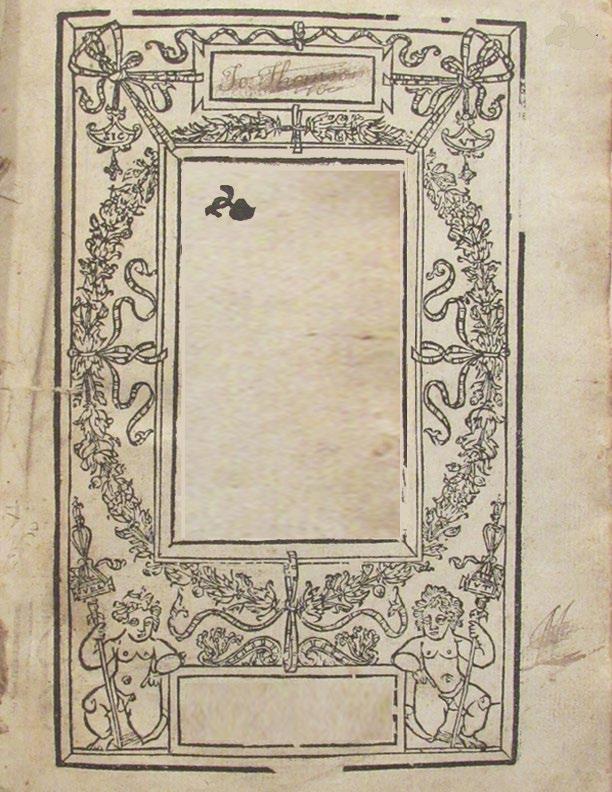
Very Rare English Incunabula - Higden’s Polycronicon
Wynkyn de Worde’s Very Rare Printing of 1495
The First English Book With Printed Music
1 [Polycronicon; English Incunabula]; Higden, Ranulf; [Music]. [POLYCRONICON] (Westminster: Wynkyn de Worde, 13 April, 1495]) A very substantial fragment, being 220 (of 398) leaves, of only the second edition of Higden’s great universal chronicle in English, printed by William Caxton’s successor at Westminster, Wynkyn de Worde. Duffs type 4 throughout, woodcut initials, printed music to leaf n5 recto, Higden’s discussion of the work of Pythagoras provides the occasion for the printing of a musical example in the present edition, making this also the first English book to contain printed music. Chancery folio (256 x 178 mm.), in later full red calf, the panelled spine lettered in gilt between tall raised bands, bookplate of the family of Edward Norris. 220 (of 398) leaves, wanting those before fl, leaves gl and g8, and all after K1. A rare survival and substantial fragment, the leaves of gatherings f and g mounted at inner margin, with some additional small repairs, affecting small portions of text on 10 leaves, numerous other leaves (gatherings A11-18) neatly mounted at inner edges, a few minor tears and repairs elsewhere, light dampstaining and thumbing, heaviest to early leaves, the word ‘Pope’ and its contractions deleted throughout in sixteenth-century manuscript. Numerous early annotations, including the inscription (in two places) of Robert Crystyn.
AN IMPORTANT EDITION OF THE POLYCRONICON, the most influential universal chronicle distributed in Britain during the 14th and 15th centuries AND The first English book to contain printed music. This is the second edition of the Polycronicon in English and was printed by Wynkyn de Worde. Caxton had died in 1491, at which time his workshop, types and printer’s device were taken over by his foreman de Worde. The Polycronicon, first printed by Caxton in 1482, was composed by the fourteenth-century Higden, a Benedictine monk of St Werberg’s, Chester, and was widely circulated in manuscript. Its longevity was secured by John Trevisa, who translated it into English in 1387, and it is Trevisa’s text which is reproduced in Caxton and de Worde’s editions. The work draws on over 40 sources, and synthesizes a continuous diachronic and multicultural history, beginning with the Biblical account of the Creation and moving through the history of the Semitic, Hellenic, Roman, and medieval-European cultures. It served as a model for innumerable later histories, both universal and localized.
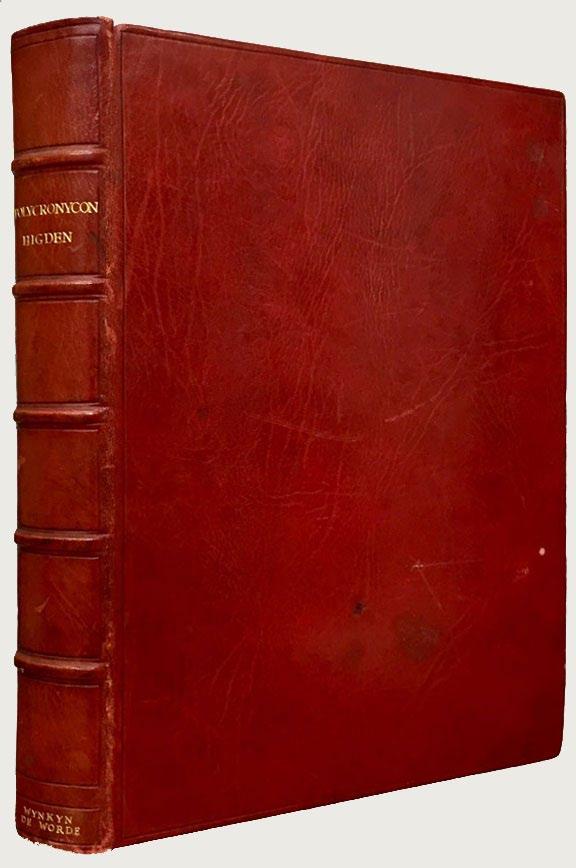
Higden’s POLYCRONICON enjoyed considerable popularity in the 15th century. It was the standard work on general history, and more than a hundred manuscripts of it are known to exist.
Hain 8660; Goff H-268; STC 13439; R. Steele, The Earliest English Music Printing, 1903, 1. $65,000.
Virgil’s Aeneid - 1553 - Very Rare
The First Metrical Translation of a Classic to a Native British Tongue
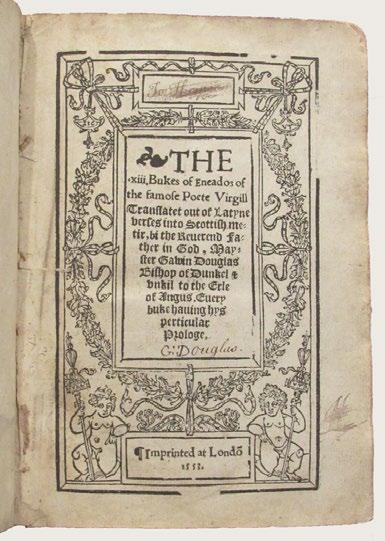
2 [Virgil]; Vergilius Maro, `Publius (70-19 BCE). THE XIII BUKES OF ENEADOS OF THE FAMOSE POETE VIRGILL. Translatet out of Latyne verses into Scottish metir, bi the Reverend father in God, Mayster Gawin Douglas Bishop of Dunkel & unkil to the Erle of Angus. Every buke having hys perticular Prologe (London: (W. Copland), 1553) Very Rare First Edition of the first translation of Virgil’s Aeneid into Scots, and the first into any vernacular British tongue. Black letter, woodcut initials, title and imprint within illustrated woodcut border [McKerrow & Ferguson 49) several woodcut initials throughout. Quarto-in8s (200 x 140mm), 17th century paneled calf, later lettered ‘Charleton’ in gilt on upper cover, spine in six compartments. An excellent copy, perhaps lacking final blank bb8 although Pforzheimer suggests this was used to print the ninth leaf in gathering X present here, some staining to Cl-6, a few other leaves with some light staining, some soiling, some wear to top corners from gathering u on, some softening of paper at fore-edges of final few leaves with consequential light chipping, light dampstain from gathering z. With the scarce leaf [bb7] with ‘Ane exclamacion aganis detractouris,’. Spine with wear and with a few remnants of label, top corner of lower board softened.
FIRST EDITION OF THE FIRST TRANSLATION OF THE AENEID INTO ENGLISH (Scots dialect) AND THE FIRST METRICAL VERSION OF A CLASSIC IN ANY NATIVE BRITISH LANGUAGE. Gavin Douglas (c.1476-1522), the bishop of Dunkeld, was a poet heavily influenced by classical literature and was the last of the great Scottish Chaucerians. In 1501, he composed the long and complex The Palice of Honour using the form of an allegorical dream. By 1513, he had completed his translation of the Aeneid, ‘Douglas’s greatest claim to fame’ (ODNB). The result was pioneering and hugely influential. Where Caxton’s recent publication was more of a free-form rendering, Douglas set great store by attempting a faithful translation using contemporary editions and explanatory glosses indicating wide reading and depth of knowledge. ‘In the early 1500s no major classical work had been translated into English ... Douglas shared the values of the humanists: an antipathy to scholasticism, respect for classical authors, and a zeal for education. He wished to communicate to his countrymen a knowledge of the Aeneid, and also to enrich his native “Scottis” tongue with something of the “fouth”, or copiousness, of Latin’ (ODNB). In addition to the epic, Douglas composed his own original verse prologues to each of the books, through which we hear the translator’s thoughts and ideas on Virgil, Chaucer, the problems of translation, and even glimpses of the poet in the throes of composition. The 12 books are supplemented by Douglas’ translation of Maffeo Vegio’s extra verse that was routinely added as a thirteenth book to editions of the Aeneid until the 17th century. His principal work, this translation of Virgil with the added thirteenth book by Maffeo Vegio, was composed about 1512, and remains one of the monuments of early sixteenthcentury vernacular verse.
Although the printer remains anonymous, Pforheimer ascribes it to William Copland on the basis that it was meant to be published together with his printing of Douglas’ The Pa/ice of Honour (one of Cambridge University’s copies is thus bound). Ezra Pound was so taken with this translation as to suggest that it was in some respects better than Virgil’s original (Douglas, he declared, had ‘a better knowledge of the sea’) and C. S. Lewis was among its warmest latter-day adherents (a ‘great work...nearer to the original than any version could be which kept within the limits of later “classicism”’).
Provenance: John Thomson of Charleton (1710-1787; ink ownership inscription dated 1760 on title, and engraved
armorial bookplate dated 1786; thence by descent to his grandson:) - J. A[nstruther-] Thomson (1776-1833; ink ownership inscription on preliminary leaf) - ‘J.M.L.’ (ink cipher, semi-erased in margin of title, repeated on verso of final leaf). Late 18th / early 19th-century ink pen trail on verso of title with words ‘Talmash Ceall of Dysart’ within frame with decorative cornerpieces - ‘Gawin Douglas’ (later ink inscription) perhaps solving the cryptic clue ‘To knaw the name of the translator’ given on verso of final text leaf bb7.
STC 24797; Pforzheimer 1027; ESTC S119190.
STC24797; Pforzheimer 1027. $62,500.
A Great Rarity - An Important English Renaissance Work
Sir Thomas More - The Confutacyon of Tyndales Answere Published in London by Rastell - 1532-1533
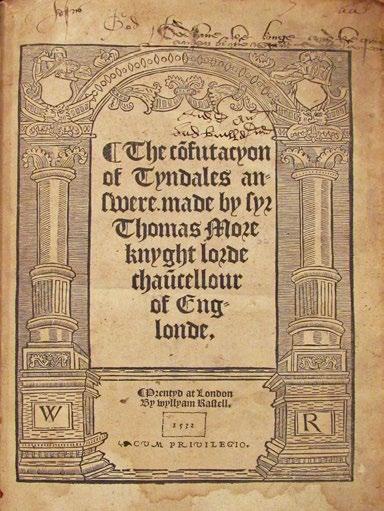
3 More, Sir Thomas. THE CO[N]FUTACYON OF TYNDALES ANSWERE [-THE SECOND PARTE OF THE CO[N]FUTACION OF TYNDALS ANSWERE (London: Printed by W. Rastell, 1532 [-33]) 2 works comprising 9 parts together in 1 volume. First Edition black letter and italics, titles within architectural woodcut borders, woodcut initials throughout. Folio, 10.25” x 7.25” x 2.75”, bound in contemporary calf, covers with gilt-stamped central ornament of foliage and floral motifs, recornered and neatly rebacked, retaining much of original backstrip. Approximately 900 pages. First part with final errata folio, second part with blank y6 but final folio of text (2G4) tipped in facsimile, title of first part with contemporary ink inscriptions, some staining and soiling with chipping to margins, some chipping and damage to margins of 2G3, occasional staining and light soiling, heavier at start of first part, occasional contemporary ink notes in 2 hands (one referencing the sermons of Latimer) and fingerposts to margins,
AN INCREDIBLY RARE FIRST EDITION OF BOTH PARTS of Sir Thomas More’s The Co[n]futacyon of Tyndales Answere, bound together in contemporary calf, acquired from the Fox Pointe Manor Library.
The first part was written and published in 1532, while More was Lord Chancellor of England, and the second part was published in 1533, subsequent to his resignation.A highly important work on Roman Catholic theological polemics and constitutes the most massive work of its kind written in English. More worked so hard and compulsively on it while Chancellor that he advised Henry VIII that his chest pains (a factor in his resignation as Lord Chancellor) were in part attributable to the efforts he expended on the project. Both parts of More’s voluminous response to Tyndale’s An Answer unto Sir Thomas More’s Dialogue, now rarely found together,with contemporary annotations by a Catholic sympathizer. More’s response is set in the form of a dialogue between himself and Tyndale (with Tyndale’s statements presented in a rather attractive italic font), both parts were published by More’s nephew William Rastell, the second part was published after More’s death. $26,000.
Extremely Rare - Only One Copy at Auction in 25 Years
Sir Thomas More - The Deballacyon of Salem and Bizance
First Edition - Printed in London - 1533
4 More, Sir Thomas. THE DEBALLACYON OF SALEM AND BIZANCE (London: Printed by W. Rastell, 1533)
Two parts in one volume. First Edition Black letter, title within woodcut border, woodcut historiated initials. 8vo, bound in early twentieth-century brown crushed levant morocco by Riviere and Son. Covers ruled in gilt and blind with gilt comer ornaments, spine ruled in gilt and blind decoratively tooled and lettered in gilt in compartments, board edges ruled in gilt, tum-ins ruled in gilt and blind, all edges gilt, marbled endpapers. Housed in a custom quarter brown morocco clamshell. ciiiL clxxiii, [2, “The fautes escaped in the pryntynge”] leaves, the copy has leaf c8 in probable facsimile. An excellent copy of this extremely rare work, preliminaries cleaned and a few other leaves with slight discoloration at upper comers, leaf a4 with crease marks to corners and short tear at upper margin, final leaves slightly discolored. A quite remarkable survival.
EXTREMELY RARE FIRST EDITION. An excellent copy of this extremely rare work. From the library of William Foyle with his bookplate. Only one other copy has appeared at auction in the last 25 years, the Bute-Martin copy, in which the second part was somewhat wormed and restored, costing a few letters per page. “Thomas More’s Debellation of Salem and Bizance is one of his most intriguing works. John Guy convincingly establishes that both St. German’s Salem and Bizance and More’s counterblast were written in the context of Henry Vlll’s attempt to secure a political revolution by altering the balance of power between church and state. This at last reveals the Debellation in it’s true light, as a document that embodies the struggle between adherents of the old and new orders at a stage when the outcome was by no means certain (Alistair Fox’s review of Volume 10 of The Yale Edition of the complete Works of St. Thomas More, edited by John Guy, in the Catholic Historic Review). “In ‘The Apologye of Syr Thomas More, Knyght, made by him Anno 1533 after he had geuen over the office of Lord Chancellour of Englande’ ([published] by W. Rastell), 1533, More defended himself against charges of undue length and personal abuse in his controversial writing; he renews the attack on Tindal and Barnes and on Christopher St. German, the anonymous author of ‘The Pacifier of the Division between Spirituality and the Temporality,’ and defends a rigorous treatment of heretics. This was answered by St. German in ‘Salem and Bizance,’ to which More retorted within a month in the ‘Debellacyon of Salem and Bizance’.another vindication of the severe punishment of heresy” (D.N.B.). “Probably in 1532 [legal writer and contraversialist Christopher Saint-German] issued, anonymously, his ‘Treatise concemynge the division betwene the spiritualite and the temporaltie’.ln it Saint-German lays the blame of the division on the clergy. It is said to have been commended to Sir Thomas More for its moderation, in contrast to his own intemperance of language. Early in 1533 More made a vigorous attack upon it in his ‘Apology’, referring to the author as ‘the pacifier’. This provoked a reply from Saint-German entitled ‘A Dialogue betwixte two Englishmen, whereof one was called Salem and the other Bizance,’ which ended the controversy” (D.N.B.).
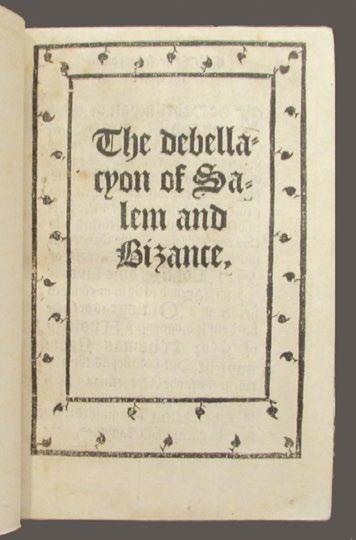
Gibson, More, 50. STC 18081. (McKerrow and Ferguson 27) (McKerrow and Ferguson 27). Gibson, More, 50. STC 18081.
$26,000.
Froissart’s “Chronicles” - Printed by Myddylton - 1542
Very Rare Printed Issues in English of this Masterwork
A Very Early and Important Production in the Language
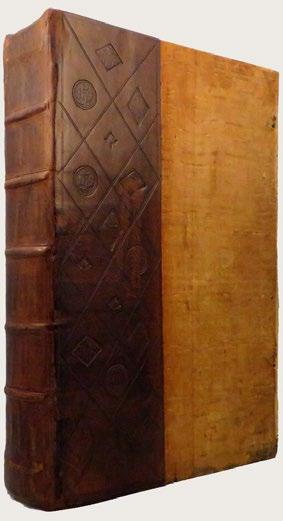
5 Froissart, Jean. [FROISSARTS CHRONYCLES]. HERE BEGYNNETH THE FYRST VOLUM OF SYR IOHAN FROYSSART OF THE CRONYCLES OF ENGLANDE, FRAUNCE, SPAYNE, PORTYNGALE, SCOTLAUDE [SIC], BRETAYNE, FLAUNDERS: AND OTHER PLACES ADIOYNYNGE. Translated out of frenche into our materall [sic] Englysshe tonge, by Iohan Bouchier [sic] knyght lorde Berners: at the co[m]maundement of our moste highe redouted souerayne lorde kynge Henry the. viii. kynge of Englande Frau[n]ce, [and] Irelande defe[n]dour of the fayth and of the churche of Englande and also of Irelande in earth the supreme heade. (London: Wyllyam Myddylton [and Richard Redman], [1542 and circa 1535]) RARE, The second edition of the translation of books 1 and 2 of the “Chroniques.” Middleton’s name and address from colophon. Publication date conjectured by STC. Includes some sheets printed by Richard Redman, ca. 1535, possibly to make up a lack of sheets in first edition stock (STC). Printed in black letter, double columns, very large and fine woodcut initials all throughout. Folio in sixes, (308 x 215 mm), very handsomely bound to style in half brown calf over antique wooden boards, the back tooled in blind with a geometic pattern, at the centers of each compartment, large medieval styled tooling, the spine with tall raised bands, the beveled outside board edge with remnants of the holes and ties from early use. A1 (title) supplied in partial facsimile; A2-A6 (Preface and Table); B1-B4 [Table]; a1-ooo4 (fol. primo-fol. CCCXXII). A very handsome and textually complete copy of this extremely rare printing. Title-page bound in on a tab, the text for the most part very well preserved and fresh, occasional evidence of old damp or other minor staining, one leaf torn at outer edge with old wax repair, a small hole effecting a few words, some worming, heavy at the prelims but quickly lessens to unobtrusive. The antique wooden boards with some age, the tooled backing in excellent condition.
ESPECIALLY RARE, THE HUNTINGTON AND MORGAN COPIES ARE THE ONLY TWO LISTED ON OCLC. THE SECOND COMPLETE EDITION IN ENGLISH OF THE FIRST TWO BOOKS OF THE GREAT CHRONICLE OF EUROPE, AND THE MOST IMPORTANT RENAISSANCE WORK OF EUROPEAN HISTORY. Translated from the French by John Bourchier, second Baron Berners (1467–1533), at the behest of King Henry VIII. “Bourchier’s English style is so vivid and so little frenchified that his translation of Froissart is justly esteemed as a classic of English literature. It was the most extensive historical work that had yet appeared in the English language, and it exercised a considerable influence on English historical writing throughout the sixteenth century and beyond. Pynson’s edition is a major monument of English printing in the sixteenth century. Complete sets are very rare; and most of the sets in institutional collections (the British Library, Ashburnham, Bodleian, Harvard and Yale copies, among others) are imperfect in some degree or wrongly made up” (quoted in the catalogue for the Garden sale, Sotheby’s New York, 8 and 9 November 1989).
“Froissart might be called the great interviewer of the Middle Ages. The newspaper correspondent of modern times has scarcely surpassed this medieval collector of intelligence. He travelled extensively in the various countries of Europe; he conversed with gentlemen of rank everywhere; and he had the remarkable knack of persuading those about him to divulge all he wanted to know. He learned the details of battles from both sides and from every point of view. He delighted in the minutest affairs of every cavalry skirmish, of the capture of every castle, and of every brave action and gallant deed. He lived from 1337 to about 1410, and wrote chiefly of contemporaneous events. The ‘Chronicles’ are universally considered as the most vivid and faithful picture we have of events in the fourteenth century....As a picture of the most favorable side of chivalry, the work has no equal” (Adams, Manual of Historical Literature, pp. 334-5).
“Like Froissart, Bourchier moved about amongst the noblesse; Henry VIII made him his Chancellor of the Exchequer
for life and three years previous to the publication of the first volume above, he was present with that monarch at the Field of the Cloth of Gold.”
STC (2nd ed.); 11396.5; PML 5004; ESTC, S121320. $16,950.
With Fine and Extensive Provenance
John Gower - Contemporary of Chaucer - 1554
De Confessione Amantis - A Source for William Shakespeare
6 [Early Printing in English]; Gower, Jo. [John]. DE CONFESSIONE AMANTIS [Edited by Thomas Berthelet] (London: Thomas Berthelet, 1554, March 11.) VERY RARE, only the third edition, after Caxton’s first of 1483 and Berthelet’s second of 1532. THIS COPY WITH FINE PROVENANCE: The Abel Berland Copy. Gothic type. Title within woodcut border (McKerrow & Ferguson 26), several woodcut initials throughout. 4to, in sixes (267 x 188 mm), in very fine 19th century English full red morocco gilt, the boards gilt-paneled in impressive Restoration style, the spine with exquisitely gilt tooled compartments between gilt ruled and stippled bands, lettered in one compartment and at the foot in gilt, the page edges beautifully gauffered in gilt, the board edges and turn-ins gilt tooled, endpapers marbled. A very fine and impressive binding. [6 ff], CXCL ff. A very fine and beautiful copy with many generations of fine provenance. The binding very fine and handsome, strong and in excellent state, the text quite clean and fresh and well preserved, title with lower inner margin expertly repaired, a few wormholes occasionally touching letters, N3 shaved close at head, small rust-hole on Z6 catching a few letters only, annotations in several early hands, occasional penciled marginalia, final blank renewed.
VERY RARE EARLY PRINTING OF THIS IMPORTANT ENGLISH WORK. Johnson wrote in his Dictionary: “He that reads the works of Gower will find smooth numbers and easy rhymes, of which Chaucer is supposed to have been the inventor, and the French words, whether good or bad, of which Chaucer is charged as the inventor.”
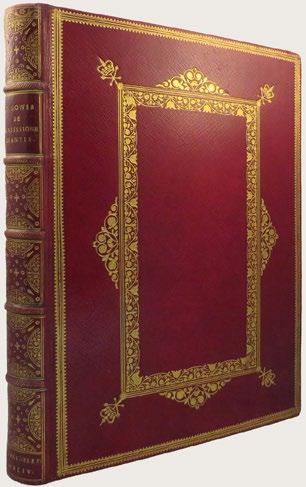
The Confessio Amantis is a poem which uses the confessions made by an aging lover to the chaplain of Venus as a frame story for a collection of shorter narrative poems. According to its prologue, it was composed at the request of Richard II. It stands with the works of Chaucer and Langland as the great works of 14th century English literature. For sources Gower relied largely on Ovid, but others include the Bible and various other classical writers. These were sources shared by Gower’s with his close friend, Geoffrey Chaucer. CONFESSIO has two stories also told in the CANTERBURY TALES, the tale of Florent, also told by the Wife of Bath, and the tale of Constance, which in Chaucer is the Man of Lawes Tale. Another one of Gower’s narratives, ‘Apollonius of Tyre’ served as a source for William Shakespeare. Shakespeare drew from it the plot for his ‘Pericles’, and introduces Gower himself as Chorus, who opens each act with a prologue.
This edition is essentially a reprint of the second edition of 1532, with some corrections and with the text of the preliminary leaves a bit compressed. This copy with exceptional provenance, Iltyd Nicholl (stamp on flyleaf and bookplate) -- Digby Nicholl (stamp on flyleaf) -- William Marchbank (armorial bookplate) -- E.M. Cox (bookplate and initials pencilled on rear flyleaf, 1904) and Abel Berland, with his famous bookplate. Pforzheimer 422; STC 12144. $18,000.
Very Rare First and Only Antiquarian Edition
The Most Famous of Tudor Poems – The Spider and the Flie
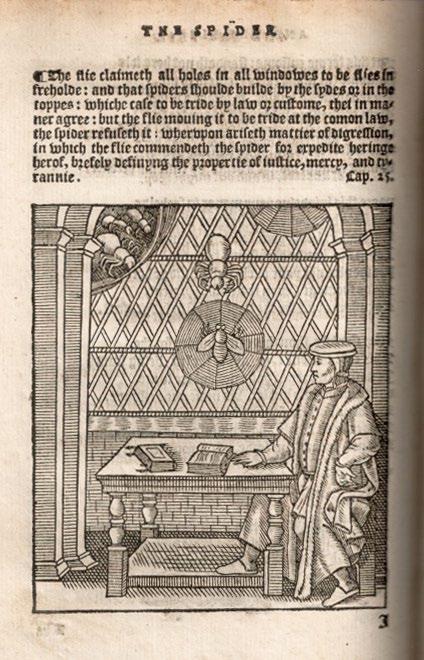
7 Heywood, John. A PARABLE OF THE SPIDER AND THE FLIE, Made by John Heywood (London: Tho. Powell, 1556) VERY RARE. FIRST EDITION of one of the most curious allegorical poems of the Elizabethan period and an exceptional early English woodcut book. This the Abel Berland copy with his famous ex-libris to the upper pastedown. Approximately thirty 3/4 page woodcuts and 10 full page woodcuts, most of which are repeated several times throughout the text (for a total of 118 woodcut illustrations). In addition there are four woodcut tailpieces (each used many times, a total of 73 impressions.) There are also two full-page portraits of the author. 4to (182 x 132 mm), beautifully bound in very handsome 19th c. full maroon straight grain morocco, tooled in blind and gilt on both covers and spine, titled and dated on spine in gilt, author’s name on a small gilt lettered brown morocco label, tooled edges and dentelles, covers tooled in gilt and blind in an arrangement of large diamonds, these alternately filled with a lattice of gilt rules, or repeated blind impressions of a small lozenge stamp, gilt spine, edges gilt, very attractive gauffered edges in a pattern reminiscent of a medieval binding, gilt turn-ins, sewn headbands, silk marker. All in all, a highly ‘original’ binding, very well executed and sturdy. A fine and handsomely preserved copy of this rare book, A1 (title), C4 and final leaf S4 supplied in expert, essentially indiscernible facsimile.
VERY RARE FIRST AND ONLY EDITION, WITH VERY FINE PROVENANCE, THE ABEL BERLAND COPY, AND A VERY RARE BOOK.
Interpretations of this, the most famous of Tudor poems, abound. Heywood himself, who took twenty years to finish the Spider and the Flie, didn’t know quite what to make of it when it was finally completed. Whomever (or whatever) the spiders and the flies were supposed to represent (the prevailing critical interpretation has the spiders as the Protestant monarchy and the flies as the persecuted Catholics, Heywood clearly has the flies as underdogs, and he roots for them throughout.
Since the political weather in England during the period of Heywood’s composition was arguably the stormiest in the nation’s history, it isn’t surprising that the poem is difficult to interpret. He may have simply kept adjusting his loyalties, depending on whomever was being oppressed. One thing is certain, though—Heywood was forever loyal to Mary (who is represented by the maid with the broom in the last series of woodcuts). When Elizabeth accessed, Heywood fled to the Brabant, where he died in the 1580s. Aside from The Spider and the Flie, Heywood’s literary legacy includes books of epigrams and proverbs, a half-dozen plays, and a volume of collected works (which does not include the present poem), all of which were popular and often reprinted. Heywood was a distant cousin to Thomas More, and grandfather of John Donne.
“...the illustrations and decorations as well as the general typographical excellence make this book outstanding among English work of the time,” —William A. Jackson; Catalogue of the Pforzheimer Collection, 1940.
VERY RARE. Before this copy came to market, only the Houghton copy had appeared at auction in the last quarter century (in the Houghton sale in 1979 and again in 1995, both Christie’s, London). Abel Berland, along with Robert Hoe, and J. R. Abbey, was a foremost collector of English literature in the 20th century, the sale of his library realized over $14 million. SIC 13308. Pforzheimer 472. $24,000.
The Rare First Printing of Aristotle in English Aristotles Politiques, or, Discourses of Government Printed in London by Adam Islip - 1598
8 Aristotle, [Politics]. ARISTOTLES POLITIQUES, OR, DISCOURSES OF GOVERNMENT Translated Out Of Greek Into French, With Expositions Taken Out Of The Best Authors, Specially Out Of Aristotle Himselfe, And Out Of Plato, By Loys Le Roy, Called Regius. Translated Out of French Into English (London: Published by Adam Islip, 1598 [published date: 1598]) Rare First Edition in English. Title page with woodcut-engraved device, woodcut-engraved initials, head and tailpieces Folio, 12” x 8”; Collated complete. (A-NN6 [-A1 & NN6]), Fine contemporary full brown calf binding, spine with five double gilt rules. [2, blank], [30], 393, [5], [2, blanks] pp. A well preserved copy of this important book.
RARE FIRST EDITION IN ENGLISH OF ARISTOTLE’S POLITICS AND ESSENTIALLY THE EARLIEST OBTAINABLE ENGLISH LANGUAGE PRINTING OF ARISTOTLE. One of the foundational texts of political theory, Aristotle here analyzes the idea and possible forms of polity using his four causes and determines constitutional government to be the preferred form. This English language edition of Politics was of great import at the time of its publication, as the first tremors of self-government were beginning to shake England from monarchic absolutism. Aristotle’s influence upon philosophical thought, even to this day, cannot be overstated.
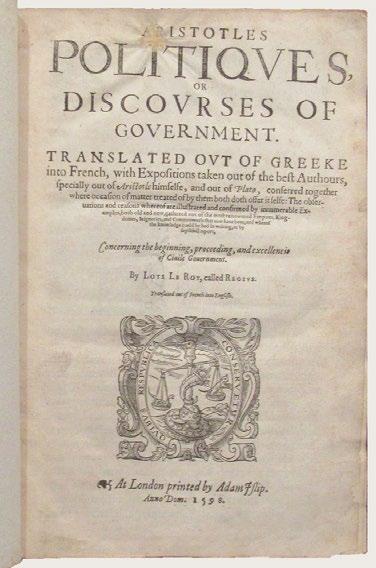
Aristotle’s history of mature Athenian democracy and the development of that city-state’s constitution greatly influenced modern political philosophy. Politics had a particularly profound effect on the formation of the United States government: Jefferson had a copy of LeRoy’s French translation in his library (Sowerby 2347), and many of the basic tenets of the U.S. Constitution derive directly from Aristotle, making him in some sense “the father of modern democracy” (PMM 94). Aristotle’s Politics (written circa 350 B.C.) “is the most valuable work on that branch of philosophy that has descended to us from antiquity” (McCulloch, 356). [STC 760; Pforzheimer 10]. $21,500.
Front cover image is adapted from item 2 All items are offered subject to prior sale. Prices are nett, shipping and insurance are extra. Contact us to place orders by phone, fax or email. All books are returnable within ten days, we ask that you notify us by phone or email in advance. Massachusetts residents are requested to include 6.25% state sales tax.
BUDDENBROOKS
21 Pleasant Street, On the Courtyard Newburyport, MA. 01950, USA
(617) 536-4433 F: (978) 358-7805 Info@buddenbrooks.com or Buddenbrooks@att.net www.Buddenbrooks.com
